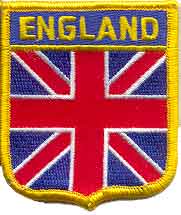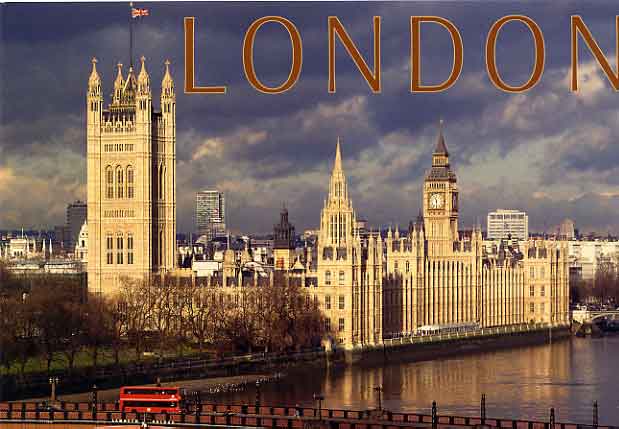

| England |  |
|
London, England - April 2003
A Post Card from
Rich Seibert
 Having a 'Jolly 'Ole
Time' in London. I have spent the last couple of days walking all
over.
Having a 'Jolly 'Ole
Time' in London. I have spent the last couple of days walking all
over.
Today I saw the Peace Protestors outside of the Parliament Building and heard the bells sound at St. Martin-in-the-Fields. Tomorrow I head out to Eastcote to prepare for my presentation.
Sure wishing I had a
travel companion - someone to go 'ooh- aah' with.  The hotel, "The
Sherlock Holmes Hotel" on Parker Street is nice.
The hotel, "The
Sherlock Holmes Hotel" on Parker Street is nice.
Hope all is well back in Rockville.
England - May 1985
Vicky Blitz
|
Ah, to be in England when the frost is on the pumpkin. Well, we were
there in May and there were no pumpkins, and there was no frost, in
fact there wasn't even any rain, until we got into Scotland. We had beautiful weather, and contrary to popular belief, the food was
wonderful. Perhaps, Globus, our touring company, saw to that. In London, we stayed in Novato Hotel which was old and a bit shabby, but adequate, and after we hit the road, our rooms got better and better. In my journal, I describe them as lovely, beautiful, almost
elegant, etc. For the reluctant first-time foreign traveler, London, England is, perhaps, a good place to start. Culture shock would be at a minimum, although there are differences, aside from the charming British accent. "Carry Outs" are called "Take Aways", "Yield" signs read "Give Way"; Freeways are called "Motorways", etc. There are double-decker busses, the taxis are tall and black, road workers wear citron green vests, and the phone booths are red. It is not all that different from being at home in the good old U.S.A. Upon arrival, my husband and I had lunch in a little cafe, Le Pub, just off the lobby of our hotel, Novetel. We had steak tip pie and bitter lemon which was quite good. We then ventured out and lucked in to a super cab driver who gave us a running commentary about the city in route to the British Museum. Arriving there we went straight to the Egyptian collection which was, remarkable to say the least. The Elgin Marbles!
After breakfast in our room, we joined our
tour group to visit Hampton As we stood inside the court yard, the guide explained that the government now houses elderly pensioners in the many rooms. For some reason I made the statement: "Well, I hope they don't permit smoking in those ancient rooms. I'll bet if a fire ever got started in those old wooden floors, the whole place will go up like a tinderbox." We were facing the wing in the lower right hand corner, above. Sure enough, a few years later that is exactly what happened. I'm sure they have restored it by now, at least I hope. It is certainly a lovely old place. We stopped in Winchester, where we were free to explore the town, have lunch and meet back at the bus. Bob and I discovered the lovely Royal Oak Pub, established in 1742 and had a really great lunch of steak and kidney pie and a glass of Guinness Stote (ale). Outside the pub we stopped for a picture at the "market cross" where, in days gone by, they used to make announcements and where the town crier cried. At Salisbury we visited the cathedral, built in 1290, where a copy of the Magna Charta is housed. The entire area is a chalk deposit, 300 feet deep, a build-up of shells and fish bones over a millennium, during a time when it was under the sea. There are no little streams where there should be streams because, unless it rains very hard, there is no run off. Rain water goes right into the chalk ground. And so, over time, there have developed gentle depressions between the hills instead of creeks and streams. These depressions are called borns.
We spent the night in Exeter and the next morning we drove through the moors, seeing many sheep with their new lambs, roaming the fields. A beautiful day and a beautiful countryside with it's black rocks and gorse. We took our mid-morning break at Widecombe in the Moore (combe means valley but actually it was on the side of a hill) where I enjoyed a creamed tea at the cafe. On the other side of the road was St Paucras Church which looked very old and should have as it was built before Columbus discovered America. On to Plymouth and a picture taking session of a memorial to the Mayflower sailing on September 6, 1620. Among several other plaques was one acknowledging the first trans Atlantic flight there at Barbacan. Back through moors to the west and through the Dartmore National Park. It may be of interest that the moors make their own weather, which is ignored by the national weather forecasters. Our guide told us it can turn very nasty within an hour. We visited the ruins of the church at
Glastonbury which is supposed
During World War II, Hitler had planned to live her after the war and when he saw he would loose the war, he sent two successive nightly bombings to destroy it but did not succeed. His bombs only hit the poor sections and they missed the lovely part of the city altogether. The area was never rebuilt. The next day, our guide gave us a lecture about the differences of the peoples that inhabited the region. He said the Vikings and the Danes were the tallest ethnic group with red and blond hair. The Celts were paler, shorter, thinner and more delicate. The Iberians, from Spain and Portugal, were short and stocky with dark hair and skin and were the fierce, forest people. The Celts were afraid of them and warned their children to "stay out of the woods or the boogiemen might catch you." And that is how that phrase originated. After spending a night in Chester, we
did a walking tour of the
On to the beautiful Lake District and Lake Windermere. We walked the streets of Grasmere, took pictures of the cute little shops, the lake, the rugged mountain hills, had lunch and just generally enjoyed being there. What a wonderful place for a vacation. We had a visit at Dove Cottage, the home of William Wardsworth, the English poet (1770-1850), which sits on the mountain overlooking the lake. Our hostess and tour guide was his great, great grand daughter. We had the nicest rooms to date at the
Prince of Wales Hotel but the After passing through Gretna Green (famed for being the town where the blacksmith used to marry eloping couples), we crossed over the boarder into Scotland. (Continued: Click on Countries - Scotland) After five days in Scotland, we returned to England and headed south, stopping to do a walking tour of the old part of York, which included the cathedral, the twelfth century Norman, Gothic barracks, St. Leonard's Hospital ruins, built in the 1200's. I mused how they treasure their old buildings and how egger we, in America, are to tear ours down and replace them with steel and glass, and how sad that is. We spent the night at the Hospitality Inn in Harrogate. We had a lovely old room with everything but a shower, but I loved it. The next day we stopped at Coventry. This is the town where Lady Godiva rode nude on her horse through the streets so that her husband would ease up on the taxes he was imposing on the people. But Tom...Peeping Tom, that is...was struck blind for peeping at her as she rode through the town with her long blond hair flowing.
At Stratford-on-Avon we saw the Ann Hathaway
Family home, built in 1470, We checked into the Stratford Moat House, where we had the best rooms and food of the trip to date. After a two hour break for a nap or a "freshening-up", we got back on the bus for a drive through the Cotswold's, the area where the wool industry started in England in the 1500's. There were pretty English gardens and quaint thatched roofs, a photographer's delight. We stopped in Bretforton at The Fleece, for drinks and I had my first shandy. This was reputed to be the oldest pub in Britain, dating back 500 - 600 years. Bretforton, itself, dates back more than 1200 years to a Saxon deed of 714.
Oxford University is a collection of 36 independent Colleges but we only saw the Balliol College Quadrant, the Modern Language College, the "New College" (which was 200 years old), the Old College (400 years old) with it's connecting bridge over the street (reminding us of the Bridge of Sighs in Venice), Bodleian Library of Oxford (equivalent the our Library of Congress in the U.S.), etc. The first college was established in Oxford in the twelfth century. There are between 500 - 700 students in each college. Our final stop was Windsor Castle which has every bit the charm and elegance of what one would expect from a castle begun by William the Conqueror, and loved by Queen Elizabeth. One can just imagine princes and princesses playing in the yard, running back and forth chasing each other, playing ring-around-the-rosy (which is actually a rhyme about the Black Plague), etc.
As impressive as the rooms are, my
favorite was the large St George's We had one little snafu before our final night in England. Back in London, just before our last dinner together with the tour group, husband Bob lost his passport. This was not a good thing just before leaving the country. However, the next morning at Heathrow he was able to finally get in touch with the proper authorities at the American Embassy, who I might add, were not pleased, but permitted us to board our plane and deal with it upon arrival in Dulles International back home. We were informed upon arrival that they would let us through customs but it would cost us $60.00.
Along the English coast, facing Holland, windmills still dot the landscape in a region of shallow waterways and ponds popularly known as the Norfolk Broads.
|